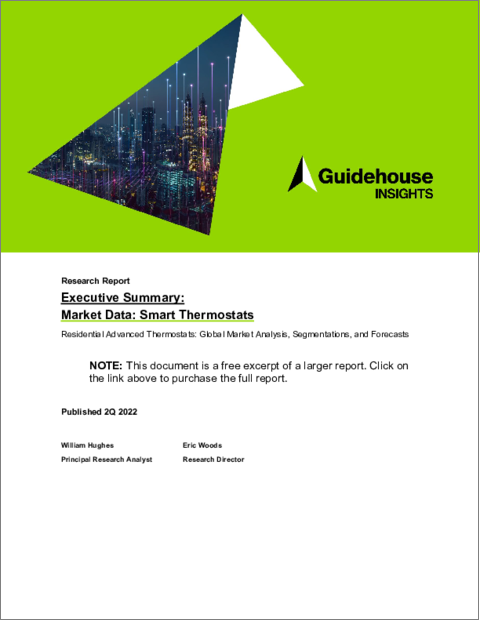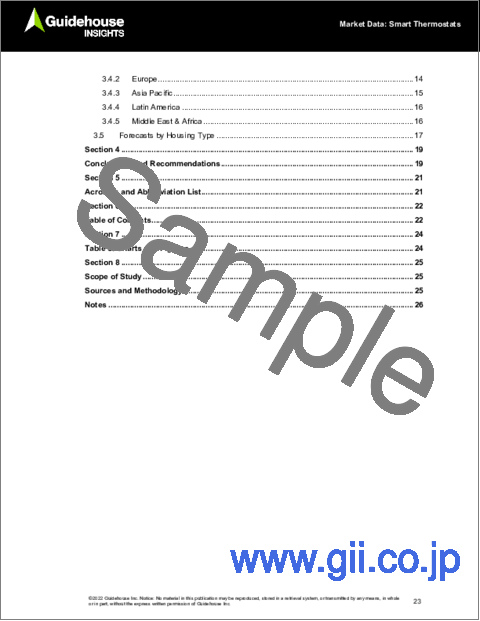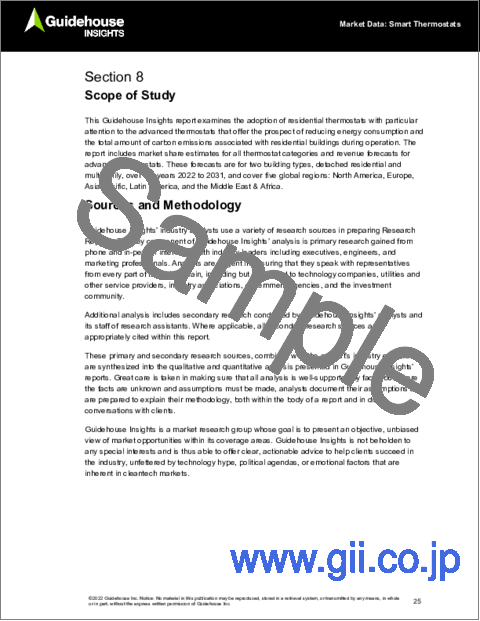|
|
市場調査レポート
商品コード
1074012
スマートサーモスタットの世界市場:住宅用アドバンストサーモスタットの分析、セグメンテーション、予測Market Data - Smart Thermostats - Residential Advanced Thermostats: Global Market Analysis, Segmentations, and Forecasts |
||||||
| スマートサーモスタットの世界市場:住宅用アドバンストサーモスタットの分析、セグメンテーション、予測 |
|
出版日: 2022年05月10日
発行: Guidehouse Insights
ページ情報: 英文 27 Pages; 36 Tables, Charts & Figures
納期: 即納可能
|
- 全表示
- 概要
- 図表
- 目次
世界のアドバンストサーモスタットの市場規模は、8.4%のCAGRで推移し、2022年の34億米ドルから2031年までには69億米ドルに達すると予測されています。 成長の大半はアジア太平洋市場で、中国での多世帯住宅の大幅な成長に関連しています。
エネルギー価格の上昇や、社会が環境配慮のために電力使用量を削減に向かう中、優先順位は電力使用量、快適性、利便性の管理へ移行しています。アドバンストサーモスタットは、この3つすべてで優れています。その効果や性能は、今後数年のうちに、家庭が指定する機器から、電力会社と家庭が協力してピーク時の電力負荷を管理するための機器へと変化していくと予想されています。
当レポートでは、世界のスマートサーモスタット市場を調査し、市場の促進要因・障壁などの問題、市場予測などの情報を提供しています。
目次
第1章 エグゼクティブサマリー
- イントロダクション
- 市場動向
- 市場予測
第2章 市場の問題
- 技術の範囲と動向
- 市場促進要因
- 住宅所有者のエネルギー効率化によるコスト削減
- ユーティリティグリッドの環境と容量に関する懸念
- サーモスタットメーカー間の競合
- 住宅所有者の環境への懸念
- スマートホームの成長
- 市場の障壁
- 一貫性のない結果
- 不適合HVAC機器
- スマートホーム技術との複雑な統合
- 賃貸人と建物所有者の間でのインセンティブの分割
- 高くなる可能性がある初期費用
- 小売業者、HVAC請負業者、およびスマートホームベンダーチャネルの競合
- プライバシーとデータセキュリティ
- サーモスタット使用に関する文化的規範
第3章 市場予測
- 技術と範囲
- サーモスタットの浸透
- スマートサーモスタットと通信型サーモスタットの予測
- 地域予測
- 北米
- 欧州
- アジア太平洋
- ラテンアメリカ
- 中東・アフリカ
- 予測:住宅タイプ別
第4章 結論と提言
第5章 頭字語と略語のリスト
第6章 目次
第7章 図表
第8章 調査範囲、情報源と調査手法、メモ
LIST OF CHARTS AND FIGURES
- Advanced Thermostat Device Revenue by Region, World Markets: 2022-2031
- Thermostat Penetration by Type, World Markets: 2022-2031
- Smart Thermostat Device Revenue by Region, World Markets: 2022-2031
- Communicating Thermostat Device Revenue by Region, World Markets: 2022-2031
- Advanced Thermostat Device Revenue by Segment, North America: 2022-2031
- Advanced Thermostat Device Revenue by Segment, Europe: 2022-2031
- Advanced Thermostat Device Revenue by Segment, Asia Pacific: 2022-2031
- Advanced Thermostat Device Revenue by Segment, Latin America: 2022-2031
- Advanced Thermostat Device Revenue by Segment, Middle East & Africa: 2022-2031
- Advanced Thermostat Device Shipments by Housing Type, World Markets: 2022-2031
LIST OF TABLES
- Thermostat Penetration by Type, World Markets: 2022-2031
- Advanced Thermostat Device Shipments by Region, World Markets: 2022-2031
- Advanced Thermostat Device Revenue by Region, World Markets: 2022-2031
- Smart Thermostat Device Shipments by Region, World Markets: 2022-2031
- Smart Thermostat Device Revenue by Region, World Markets: 2022-2031
- Communicating Thermostat Device Shipments by Region, World Markets: 2022-2031
- Communicating Thermostat Device Revenue by Region, World Markets: 2022-2031
- Advanced Thermostat Device Revenue by Segment, World Markets: 2022-2031
- Advanced Thermostat Device Revenue by Segment, North America: 2022-2031
- Advanced Thermostat Device Revenue by Segment, Europe: 2022-2031
- Advanced Thermostat Device Revenue by Segment, Asia Pacific: 2022-2031
- Advanced Thermostat Device Revenue by Segment, Latin America: 2022-2031
- Advanced Thermostat Device Revenue by Segment, Middle East & Africa: 2022-2031
- Advanced Thermostat Device Shipments by Housing Type, World Markets: 2022-2031
- Advanced Thermostat Device Shipments by Housing Type, North America: 2022-2031
- Advanced Thermostat Device Shipments by Housing Type, Europe: 2022-2031
- Advanced Thermostat Device Shipments by Housing Type, Asia Pacific: 2022-2031
- Advanced Thermostat Device Shipments by Housing Type, Latin America: 2022-2031
- Advanced Thermostat Device Shipments by Housing Type, Middle East & Africa: 2022-2031
- Advanced Thermostat Revenue by Housing Type, World Markets: 2022-2031
- Advanced Thermostat Revenue by Housing Type, North America: 2022-2031
- Advanced Thermostat Revenue by Housing Type, Europe: 2022-2031
- Advanced Thermostat Revenue by Housing Type, Asia Pacific: 2022-2031
- Advanced Thermostat Revenue by Housing Type, Latin America: 2022-2031
- Advanced Thermostat Revenue by Housing Type, Middle East & Africa: 2022-2031
- Evolving Capabilities of Advanced Thermostats
The traditional role of thermostats has been to provide comfort and convenience by automating temperature management. Recent enhancements incorporated into advanced thermostats support additional sensors, AI, and communications capabilities. As energy prices rise and as society moves toward reducing power use for environmental reasons, priorities are shifting to managing power usage, comfort, and convenience. Advanced thermostats excel at all three. Their effectiveness and capabilities are such that in coming years, they will shift from being a device the homeowner specifies to an instrument by which utility and homeowners collaboratively manage peak power loads.
This evolution will not take place uniformly because the current adoption of thermostats varies significantly by region. Besides climate-based variations in heating and cooling needs, individual cultures have ingrained customs and mores on the nature of heating-and sometimes cooling-that should be recognized and respected. Relationships between utilities and homeowners also affect collaboration.
This Guidehouse Insights report looks at the growth of advanced thermostats in all regions in the coming decade. It leverages Guidehouse Insights reports based on the Global Building Stock Database for 4Q21 and applies information associated with advanced thermostats, consumer buying behavior, and information from vendors. Guidehouse Insights estimates the advanced thermostat market will grow at a compound annual growth rate (CAGR) of 8.4% from $3.4 billion in 2022 to $6.9 billion by 2031. Most of the growth will be in the Asia Pacific market and is associated with the substantial growth in China for multifamily homes. The North American Market will grow at a CAGR of 1.7% from $1.6 billion in 2022 to 1.9 billion in 2031.
KEY QUESTIONS ADDRESSED:
- What are the differences between a basic, programmable, connected, and smart thermostat?
- What are the drivers and barriers affecting the thermostat market?
- How is the market for thermostats expected to grow by thermostat type?
- How is the market for thermostats expected to grow by building type?
- How is the market for thermostats expected to grow by region?
- What are recommendations and best practices for the smart thermostat market?
WHO NEEDS THIS REPORT:
- Thermostat manufacturers
- HEM software providers
- Smart home solution and component providers
- Energy monitoring companies
- Energy suppliers/Utilities
- Other service providers
- Other connected device manufacturers
- Investor community
Table of Contents
1. Executive Summary
- 1.1. Introduction
- 1.2. Market Trends
- 1.3. Market Forecast
2. Market Issues
- 2.1. Technology Scope and Trends
- 2.2. Market Drivers
- 2.2.1. Cost Savings from Energy Efficiency for Homeowners
- 2.2.2. Environmental and Capacity Concerns of Utility Grids
- 2.2.3. Competition Among Thermostat Manufacturers
- 2.2.4. Homeowners' Environmental Concerns
- 2.2.5. Growth of Smart Homes
- 2.3. Market Barriers
- 2.3.1. Inconsistent Results
- 2.3.2. Non-Conforming HVAC Equipment
- 2.3.3. Complex Integration with Smart Home Technology
- 2.3.4. Split Incentives between Renters and Building Owners
- 2.3.5. Initial Costs Can Be High
- 2.3.6. Retailers, HVAC Contractors, and Smart Home Vendor Channel Conflict
- 2.3.7. Privacy and Data Security
- 2.3.8. Cultural Norms About the Use of Thermostats
3. Market Forecasts
- 3.1. Technology and Scope
- 3.2. Thermostat Penetration
- 3.3. Smart and Communicating Thermostat Forecasts
- 3.4. Regional Forecasts
- 3.4.1. North America
- 3.4.2. Europe
- 3.4.3. Asia Pacific
- 3.4.4. Latin America
- 3.4.5. Middle East & Africa
- 3.5. Forecasts by Housing Type




